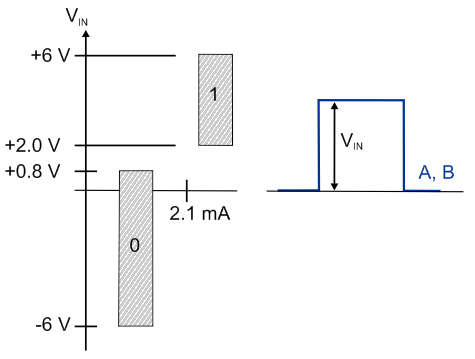Signal types
Supported encoders / signal types
Possible encoder connections are single-ended signals from TTL encoders and signals from Open Collector encoders through internal pull-up resistors.
The following signal types are supported:
Encoder | Signal type | Setting in | Cut-off frequency | Comments |
|---|---|---|---|---|
Encoder | TTL | 2 | 4 million increments / s | A voltage level of nominally 2.0 V to 6.0 V with a current of 2.1 mA or higher is expected. No broken wire detection |
Counter/pulse generator | 3 | |||
Encoder | open collector | 4 | 400,000 increments / s | No broken wire detection |
Counter/pulse generator | 5 |
The correct wiring for the respective encoder can be found in chapter Connection.
Signal type TTL (single-ended) and Open Collector
With the following settings in "Counter mode" (0x80n1:1D), a voltage level of nominally 2.0 V to 6.0 V with a current of 2.1 mA or higher is expected:
- 2: Encoder TTL (single-ended)
- 3: Counter TTL (single-ended)
- 4: Encoder open collector
- 5: Counter open collector
For TTL encoders a cut-off frequency of up to 4 million increments per second is permissible with 4-fold evaluation. This corresponds to 1 MHz.
For Open Collector encoders, a cut-off frequency of up to 400.000 increments per second is permissible with 4-fold evaluation. This corresponds to 100 kHz.
 Fig.6: TTL, Open Collector signal level (single-ended signal)
Fig.6: TTL, Open Collector signal level (single-ended signal)Key:
VIN | Single-ended input voltage |
A, B | Encoder signals A, B |
Notice | |
Open circuit detection Open circuit detection inherently does not work with single-ended lines: TTL and Open Collector encoders and counters/pulse generators. |
Notice | |
Open Collector wiring When selecting an Open Collector encoder under "Counter mode" (0x80n1:1D), the inputs A, B are connected to 5 V via pull-up resistors (1 kΩ). |